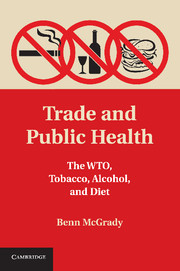23 results
Appellate Body Report, United States – Clove Cigarettes
-
- Journal:
- European Journal of Risk Regulation / Volume 3 / Issue 2 / June 2012
- Published online by Cambridge University Press:
- 20 January 2017, pp. 251-256
-
- Article
- Export citation
Philip Morris v. Uruguay: The Punta del Este Declaration on the Implementation of the WHO Framework Convention on Tobacco Control
-
- Journal:
- European Journal of Risk Regulation / Volume 2 / Issue 2 / June 2011
- Published online by Cambridge University Press:
- 20 January 2017, pp. 254-260
-
- Article
- Export citation
Panel Report US – Clove Cigarettes
-
- Journal:
- European Journal of Risk Regulation / Volume 2 / Issue 4 / December 2011
- Published online by Cambridge University Press:
- 20 January 2017, pp. 600-606
-
- Article
- Export citation
The UN General Assembly to Address Prevention and Control of Non-Communicable Diseases
-
- Journal:
- European Journal of Risk Regulation / Volume 1 / Issue 4 / December 2010
- Published online by Cambridge University Press:
- 20 January 2017, pp. 419-420
-
- Article
- Export citation
Contributors
-
-
- Book:
- Regulating Lifestyle Risks
- Published online:
- 05 January 2015
- Print publication:
- 01 January 2015, pp x-xii
-
- Chapter
- Export citation
12 - EU lifestyle policy and international law: a three-level game
- from Part II - The legality of the EU lifestyle regulatory intervention
-
-
- Book:
- Regulating Lifestyle Risks
- Published online:
- 05 January 2015
- Print publication:
- 01 January 2015, pp 263-280
-
- Chapter
- Export citation
Tobacco Control and Beyond: The Broader Implications of United States—Clove Cigarettes for Non-Communicable Diseases
-
- Journal:
- American Journal of Law & Medicine / Volume 39 / Issue 2-3 / June 2013
- Published online by Cambridge University Press:
- 06 January 2021, pp. 265-289
- Print publication:
- June 2013
-
- Article
- Export citation
4 - Necessity and Regulatory Autonomy under the GATT
-
- Book:
- Trade and Public Health
- Published online:
- 03 May 2011
- Print publication:
- 31 March 2011, pp 130-169
-
- Chapter
- Export citation
5 - Product Regulation and Labeling Measures under the SPS and TBT Agreements
-
- Book:
- Trade and Public Health
- Published online:
- 03 May 2011
- Print publication:
- 31 March 2011, pp 170-214
-
- Chapter
- Export citation
Abbreviations
-
- Book:
- Trade and Public Health
- Published online:
- 03 May 2011
- Print publication:
- 31 March 2011, pp xv-xvi
-
- Chapter
- Export citation
7 - Conclusion
-
- Book:
- Trade and Public Health
- Published online:
- 03 May 2011
- Print publication:
- 31 March 2011, pp 277-288
-
- Chapter
- Export citation

Trade and Public Health
- The WTO, Tobacco, Alcohol, and Diet
-
- Published online:
- 03 May 2011
- Print publication:
- 31 March 2011
Glossary of Basic Trade Terms
-
- Book:
- Trade and Public Health
- Published online:
- 03 May 2011
- Print publication:
- 31 March 2011, pp 289-292
-
- Chapter
- Export citation
Preface
-
- Book:
- Trade and Public Health
- Published online:
- 03 May 2011
- Print publication:
- 31 March 2011, pp xiii-xiv
-
- Chapter
- Export citation
2 - Normative Integration: Using Health Instruments in Interpretation of the WTO-Covered Agreements
-
- Book:
- Trade and Public Health
- Published online:
- 03 May 2011
- Print publication:
- 31 March 2011, pp 34-79
-
- Chapter
- Export citation
Contents
-
- Book:
- Trade and Public Health
- Published online:
- 03 May 2011
- Print publication:
- 31 March 2011, pp vii-xii
-
- Chapter
- Export citation
Frontmatter
-
- Book:
- Trade and Public Health
- Published online:
- 03 May 2011
- Print publication:
- 31 March 2011, pp i-vi
-
- Chapter
- Export citation
6 - Reallocating Authority at the International Level: Delegation, Legalization, and Harmonization
-
- Book:
- Trade and Public Health
- Published online:
- 03 May 2011
- Print publication:
- 31 March 2011, pp 215-276
-
- Chapter
- Export citation
3 - Freedom to Use Taxes, Subsidies, and Restrictions on Marketing
-
- Book:
- Trade and Public Health
- Published online:
- 03 May 2011
- Print publication:
- 31 March 2011, pp 80-129
-
- Chapter
- Export citation
1 - Intersections between Trade and Noncommunicable Disease
-
- Book:
- Trade and Public Health
- Published online:
- 03 May 2011
- Print publication:
- 31 March 2011, pp 1-33
-
- Chapter
- Export citation

